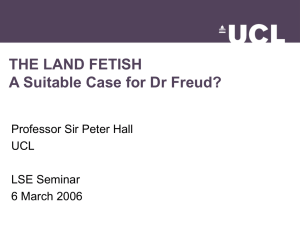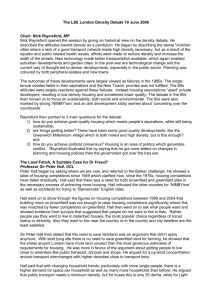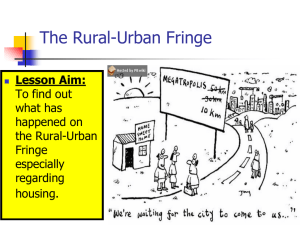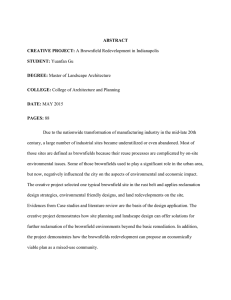THE LAND FETISH A Suitable Case for Dr Freud? UCL
advertisement
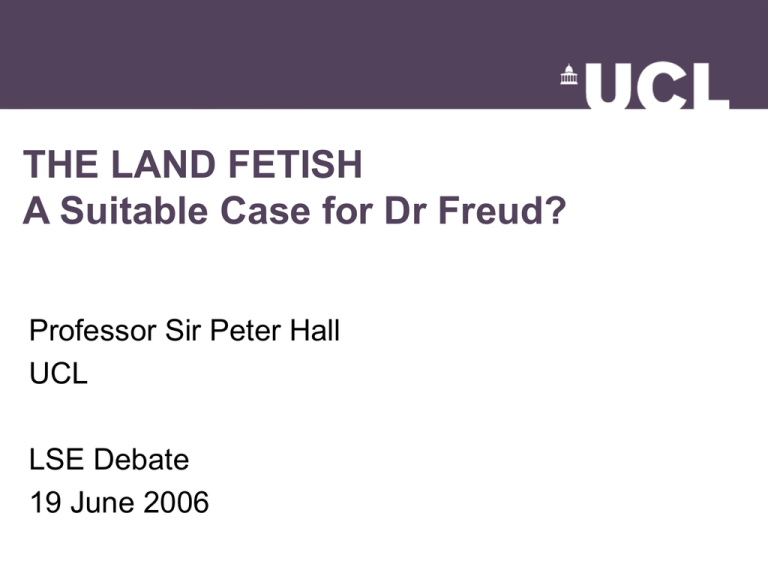
THE LAND FETISH A Suitable Case for Dr Freud? Professor Sir Peter Hall UCL LSE Debate 19 June 2006 Where Are We Now? The Barker Challenge • Need for massive increase in housing completions • Will need brownfield + greenfield • “Political” attack by shires – “unholy alliance” with cities • The architects’ crusade: “Barcelonise” our cities A Continuing Issue? Brownfield, Greenfield and the Sequential Test Housing Completions: 1999, 2004 1999 % 000s 2004 % 000s 1999-2004 % change Total Brownfield Greenfield 100 56 44 140.0 78.4 61.6 100 68 32 152.9 104.0 48.9 +9.2 +32.7 -20.6 A Continuing Issue? Brownfield, Greenfield and the Sequential Test 1999-2004 Completions % change Brownfield % change Greenfield % change -8.3 +37.9 -39.5 0.0 +27.5 -43.1 Yorks Humber +5.9 +52.9 -41.2 East Midlands -6.8 +31.7 -28.4 West Midlands -9.3 +18.3 -42.0 Eastern England +5.4 +8.4 +1.3 London +92.8 +104.5 0.0 South East +10.0 +25.9 -16.1 South West +1.9 +50.0 -28.6 England +9.2 +32.7 -20.6 Region North North West Housebuilding: Houses v Flats 1999, 2004 Dwellings: % of total 1999 Houses 2004 Flats Houses Flats North East 88 12 83 17 North West 85 15 73 27 Yorks Humber 93 7 71 29 East Midlands 93 7 86 14 West Midlands *88 *13 71 29 East of England *91 *10 78 22 London 41 59 20 80 South East 83 17 62 38 South West 90 10 74 26 England 84 16 66 34 What do people want? The Survey evidence • Home Alone (Hooper et al 1998): only 10% want a flat; 33% won’t consider a flat • CPRE (Champion et al 1998): people want to live in/near country • Hedges and Clemens (q. Breheny 1997): city dwellers least satisfied • Conclusion: we hate cities! What do people want? MORI for CABE, 2005 • Over half the population want to live in a detached house • 22% prefer a bungalow • 14% a semi-detached house • 7% a terraced house • Detached house most popular choice, regardless of social status or ethnicity • Period properties (Edwardian, Victorian, Georgian) most desirable overall: 37% Good and Bad Arguments • Bad: we must save farmland • Good: we should give people choice of access to public transport, shops, schools • By public transport as well as car • So: concentrate growth around transport interchanges • And: raise densities there (“pyramids of density”) Land Lying Idle… • EU Set-Aside: June 2004, 476,000 hectares, almost 5.0% of England • Greater SE: 100,270 hectares, 8.6% • Essex 10.7% • Hampshire 9.1% • Oxfordshire 11.4% • Bedfordshire 11.6% • Far in excess of most generous estimates of land needed for housing! New Households, New Homes • 80% one-person • But only about one-third “single never married” • Will demand more space per household: Separate kitchens/bathrooms/loos, Spare rooms, Work spaces • Land saving reduces as densities increase: • 30 dw/ha yields 60% of all potential gains, 40 dw/ha 70 per cent • So biggest gains from minimising development below 20 dw/h, not increasing 40 dw/ha+ • So: go for 30-40 dw/ha with variations: higher close to transport services (Stockholm 1952!) • But won’t achieve same person densities as before! Densification: Effects Density Dws./ha. Net Land Saved % Total Saving Land needed to accommodate 400 dwellings Area required, ha. Gross (with local facilities) % Cumulative Land Saved % Total Saving % Cumulative 10 40.0 46.3 20 20.0 20.0 50.0 50.0 25.3 21.0 45.4 45.4 30 13.3 6.7 16.7 66.7 17.9 7.4 15.9 61.3 40 10.0 3.3 8.3 75.0 14.3 3.6 7.8 69.1 50 8.0 2.0 5.0 80.0 12.1 2.2 4.8 73.9 60 6.6 1.4 3.5 83.5 10.6 1.5 3.2 77.1 Density Gradient (Rudlin+Falk) Lessons from Land Use • Public Transport needs minimum density: • Bus: 25 dw/ha • LRT: 60 dw/ha • Exceed recent densities • Big gain from 30-35 dw/ha • Plus “pyramids” up to 60 dw/ha round rail stations • Urban Task Force • Traditional – Stockholm, 1952! • Or Edwardian suburbs! The Challenge • • • • • • • • • Deliver the houses Defend a “balanced portfolio”: BF/GF Build sustainable suburbs But: can be “New Towns” too (seldom just that) Sustainable urban places – linked along transport corridors Fund the infrastructure/ Coordinate development, transport Countryside – for people! A big challenge: equal to 1950s, 1960s They did it – so we can we!
